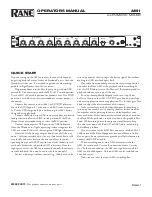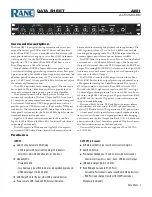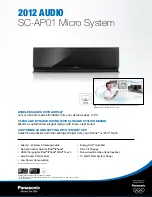
2.4.2 Mixing
Although a mixer has to perform many functions other than that of mixing,
nevertheless, this function is of predominant importance on account of the
multiplicity of input and output channels which may be involved.
In the present Mixer facilities are provided for mixing the signals from
microphone channels and applying them to group channels, for mixing signals from
microphone and/or group channels, for mixing signals from main channels and
applying them to the inputs of auxiliary stereo main channels and for mixing
auxiliary signals from various channels to send to echo or cue circuits.
In order to provide for this, each output which may require to be mixed with
signal from another channel is provided with an amplifier B which operates as a
voltage to current converter and each input into which signals are to be mixed is
provided with an amplifier C which has a virtual earth input. The circuit values are
chosen so that when an amplifier C2 follows an amplifier B, the overall gain is unity.
The output impedance of the voltage to current converter is of the order of 20k
Ω
and the virtual earth input impedance is of the order of 20
Ω
. Thus each extra
channel which is connected to the mixing point only changes the impedance at that
point by 0.1% and therefore changes the gain of existing channels by about 0.01dB.
Thus, the connection of 20 extra channels changes the gain by 0.2dB, which is
negligible.
2.4.3 Power Supply
Since a mixer for recording purposes will always be used with one or more
mains powered tape machines, there is no need to provide for battery operation of
the mixer. It is therefore designed to operate from 200/250V, 50 to 60Hz mains. If it
were essential to be able to operate from a battery or other d.c. supply, a d.c. to a.c
converter could be used.
Each cassette has a Power Unit attached to its underside, which provides
positive and negative 20V supplies from series stabilisers. The low output
impedance and the very low ripple level enable supply decoupling circuits to be cut
to a minimum. Most of the amplifiers have no decoupling.
It is advantageous for equipment to work over a considerable range of mains
voltages without any tap changing or other adjustment being necessary. If the series
stabilisers had been designed to cope with this, there would have been greater heat
dissipation in the series transistors. Although most components will operate
satisfactorily over a considerable range of temperatures, it is in general
advantageous to keep temperature rise to a minimum. A d.c. stabiliser, which gives
an output of 240V
±
1% for a range of input voltage from 204 to 252, is therefore
included in the Main Power Unit. This is followed by a step-down transformer, which
gives an output at 50V with a centre tap, which is earthed. This balanced 50V
supply is fed to the power transformers of all the cassette power units through a
screened twisted pair cable. The cassette power transformer only has to handle
about 5 watts and is therefore quite small. It is enclosed in a magnetic screening
can to minimise the risk of mains hum injection into the audio channels of the mixer.










































